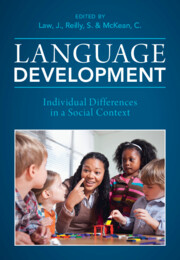Book contents
- Language Development
- Language Development
- Copyright page
- Contents
- Figures
- Tables
- Contributors
- A Tribute to Our Friend, Colleague and Fellow Editor, Professor James Law
- Introduction
- Part One Factors Influencing Language Development
- 3 Genetic Studies of Language Disorders
- 4 Hearing and Language
- 5 Co-occurrence between Language Disorders and Common Conditions in Childhood
- 6 Language and Cognition
- 7 Growing Up in Multilingual Communities
- 8 Parent–Child Interaction and Its Impact on Language Development
- 9 Cognitive Competencies and Signals of Risk
- 10 Creating Equitable Opportunities for Language and Literacy Development in Childhood and Adolescence
- Part Two Continuity and Change
- Part Three Impact, Intervention and Equity
- Index
- References
7 - Growing Up in Multilingual Communities
from Part One - Factors Influencing Language Development
Published online by Cambridge University Press: 11 August 2022
- Language Development
- Language Development
- Copyright page
- Contents
- Figures
- Tables
- Contributors
- A Tribute to Our Friend, Colleague and Fellow Editor, Professor James Law
- Introduction
- Part One Factors Influencing Language Development
- 3 Genetic Studies of Language Disorders
- 4 Hearing and Language
- 5 Co-occurrence between Language Disorders and Common Conditions in Childhood
- 6 Language and Cognition
- 7 Growing Up in Multilingual Communities
- 8 Parent–Child Interaction and Its Impact on Language Development
- 9 Cognitive Competencies and Signals of Risk
- 10 Creating Equitable Opportunities for Language and Literacy Development in Childhood and Adolescence
- Part Two Continuity and Change
- Part Three Impact, Intervention and Equity
- Index
- References
Summary
At the global level, many children learn language in bilingual or multilingual environments. They may hear and use one language at home and another at school and in the community. Some children learn more than one language in their home if the family uses more than one language in every day interactions. There is significant variability with respect to what language(s) children learn, when they learn each language, and in what context(s) each language is used. Children may hear and use different languages in the home, school and community. Developmental language disorder (DLD) affects approximately 10 per cent of the child population, including children with exposure to more than one language. A diagnosis of DLD in multilingual children should consider all languages a child hears and uses. Language learning is difficult for children with DLD and manifests across all their languages. Bilingual and multilingual children typically use forms that show the mutual influence of their languages. These influences are not indicators of DLD. Despite having difficulty with language learning, bilingual and multilingual children are not more likely to have DLD (though they may be at risk for misdiagnosis). Language intervention approaches for multilingual children with DLD should involve all their languages.
Keywords
Information
- Type
- Chapter
- Information
- Language DevelopmentIndividual Differences in a Social Context, pp. 144 - 165Publisher: Cambridge University PressPrint publication year: 2022
References
Accessibility standard: Unknown
Why this information is here
This section outlines the accessibility features of this content - including support for screen readers, full keyboard navigation and high-contrast display options. This may not be relevant for you.Accessibility Information
- 2
- Cited by
